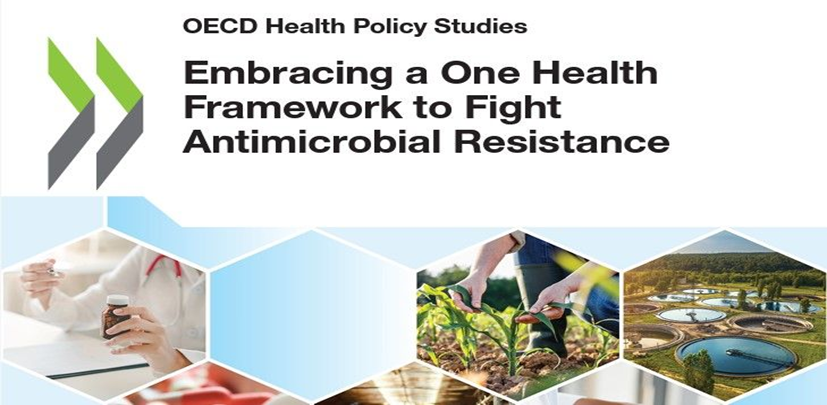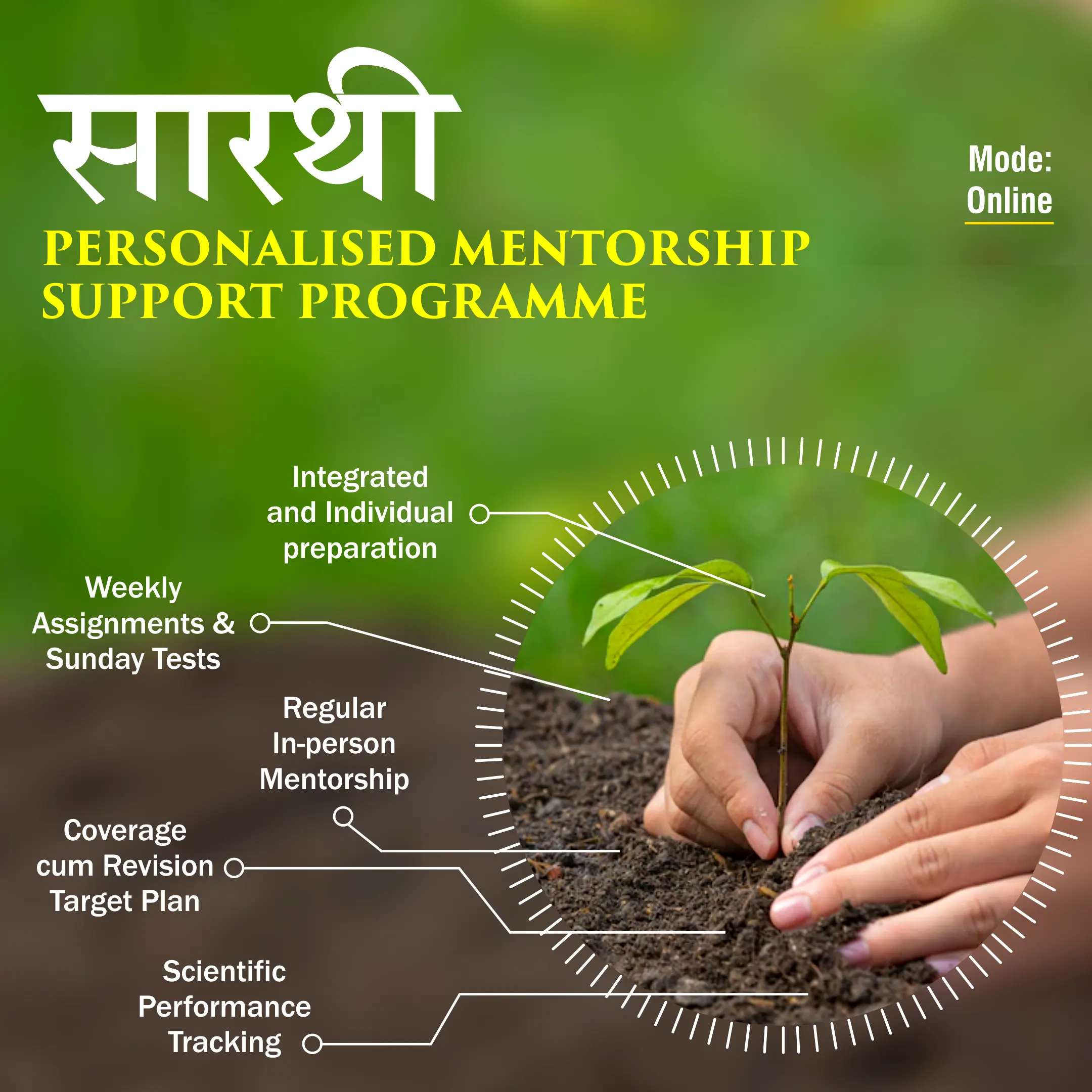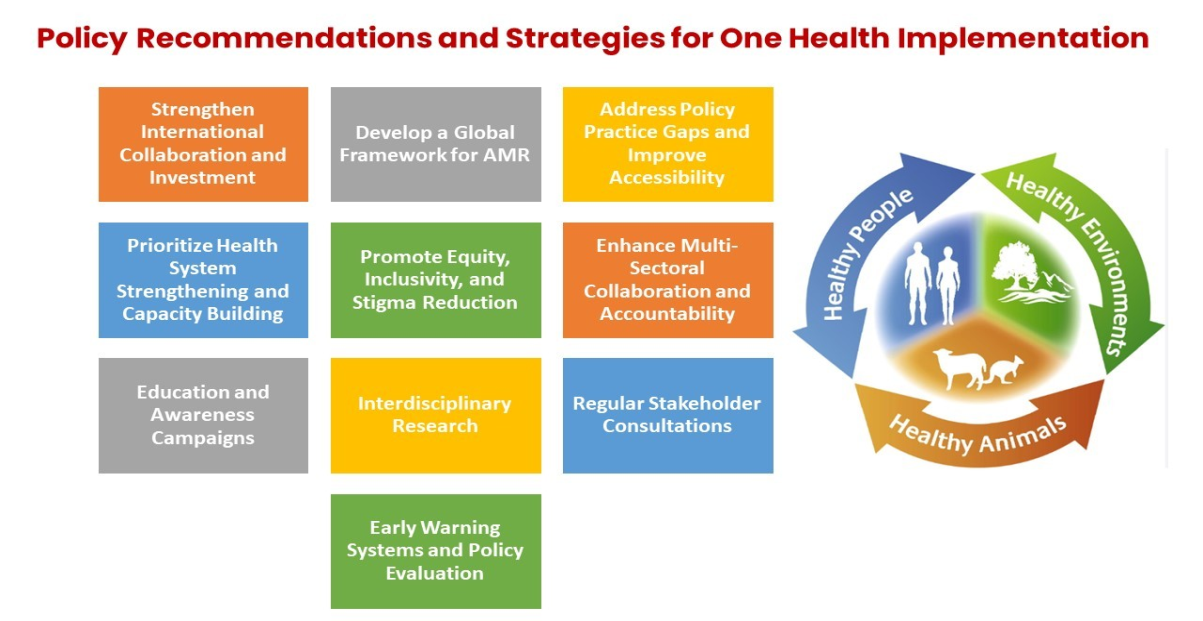
Copyright infringement not intended
Picture Courtesy: in.linkedin.com
Context: A Report released by the Organisation for Economic Co-operation and Development (OECD) recently, highlighted the critical health and economic implications of antimicrobial resistance (AMR). This report, titled "Embracing a One Health Framework to Fight Antimicrobial Resistance," drew from data provided by OECD, the European Union (EU), European Economic Area (EEA) countries, and Group of 20 (G20) countries.
Details
- Antimicrobial resistance (AMR) is recognized as a global public health crisis resulting from the excessive and inappropriate use of antibiotics across various sectors. It has led to the diminishing effectiveness of antibiotics and the emergence of antibiotic-resistant bacteria, which poses severe health risks.
Key Findings of the Report
Health and Economic Costs
- AMR is described as a "silent pandemic" due to its substantial health and economic consequences.
- It results in an estimated 79,000 deaths annually in 34 OECD and EU/EEA countries, surpassing the mortality of diseases like influenza, tuberculosis, and AIDS.
- Additionally, more than 4.3 million infections are reported annually, with a significant impact on individuals aged 65 and older.
Resistant Bacterial Strains
- Three specific bacterial strains—Escherichia coli, Klebsiella pneumonia, and Staphylococcus aureus—are responsible for a substantial portion of AMR-related deaths.
- These strains are implicated in one out of every three cases of antibiotic-resistant infections and are associated with three out of every four AMR-related deaths.
Impact on Healthcare
- Healthcare-acquired infections that are resistant to antibiotics constitute a considerable share of all resistant infections.
- These infections account for a staggering 60% of all AMR-related deaths, indicating the severe implications for patients within healthcare settings.
Extended Hospital Stays
- AMR leads to an additional 32.5 million days spent in hospitals annually, equivalent to the entire acute bed capacity of smaller countries like Spain.
- Prolonged hospitalizations due to AMR contribute to the strain on healthcare systems and resources.
Economic Costs
- The annual economic cost of AMR for 34 OECD and EU/EEA countries is projected to reach approximately $28.9 billion by the year 2050.
- The total annual cost of AMR amounts to roughly $58 per capita, with one-third of this cost attributed to increased healthcare expenditure. The remaining two-thirds stem from reduced workforce productivity, highlighting the broader economic consequences of AMR.
Antibiotic consumption trends
- Increase in Consumption: Antibiotic consumption in humans has shown a consistent increase over the past two decades. This increase has been particularly notable in G20 countries, indicating a global pattern of rising antibiotic use.
- Antibiotic consumption varies by region, with distinct percentages observed in different groups of countries:
- In OECD countries, antibiotic consumption stands at 20% of the total.
- In the EU/EEA, it is slightly higher at 22%.
- In G20 countries, antibiotic consumption is the highest, reaching 30% of the total.
- These regional differences reflect varying healthcare practices and access to antibiotics.
- Last Resort Antibiotics: Notably, the consumption of last resort antibiotics, such as polymyxins, has been on the rise. This indicates an alarming trend of increased use of antibiotics that are typically reserved for the most severe and resistant infections, suggesting a growing need for these drugs.
- Antibiotic Sales Decline: Despite the overall increase in antibiotic consumption, the report highlights a global reduction in the average sales of all classes of antibiotics over the last two decades, specifically noting a significant decline in OECD countries. This decline suggests efforts to reduce antibiotic usage, which is crucial in combatting AMR.
Antimicrobial Resistance Trends
- Resistant Proportions: In 2019, resistant proportions for 12 priority antibiotic-bacteria combinations stood at 20 percent, meaning that one in every five infections in OECD and EU/EEA countries is caused by organisms resistant to antimicrobials.
- Predicted Resistance: Without intervention, resistance to third-line antibiotics is expected to double by 2035 compared to 2005 levels. Some countries, such as India, Greece, and Türkiye, have resistance proportions above 44%.
- High Resistance: In countries with high resistance proportions, up to 90% of infections can be resistant to antibiotics.
Policy Recommendations
- The report recommends 11 One Health policy interventions to combat AMR, encompassing hospital-based and community-based approaches, as well as actions outside human health, such as improving food safety practices and biosecurity in farms. These interventions have demonstrated a substantial return on investment, ranging from 2.3 to 24.6.
|
Summary of the Report
The report underscores the urgent need to address AMR through a One Health approach and emphasizes that without such comprehensive action, AMR will continue to pose unacceptable health and economic burdens. Effective interventions can combat AMR, save lives, reduce healthcare costs, and enhance workforce productivity. However, increased global cooperation and commitment to implementing these measures are essential to mitigate the growing threat of AMR.
|
Antimicrobial resistance (AMR)
About
- Antimicrobial resistance (AMR) is a global health threat, characterized by the ability of microbes, such as bacteria, viruses, and parasites, to develop resistance to antimicrobial drugs. This phenomenon undermines the effectiveness of these drugs and poses significant challenges to healthcare systems worldwide.
- In response to the growing concern over AMR, a One Health framework has emerged as a holistic approach to combat this issue.
Features of a One Health Framework
Interdisciplinary Collaboration
- Human Health: Involves medical professionals, healthcare institutions, and policymakers responsible for human health. Collaboration with infectious disease specialists, pharmacists, and public health agencies is crucial.
- Animal Health: Includes veterinarians, animal care facilities, and relevant regulatory bodies. Veterinarians play a pivotal role in ensuring responsible antimicrobial use in animals.
- Environmental Health: This sector addresses the environmental factors contributing to AMR. It involves ecologists, environmental scientists, and policymakers focused on environmental regulations and pollution control.
- Interconnectedness: Recognizing the interconnected nature of these sectors is essential. AMR can transfer between humans, animals, and the environment through various routes, such as wastewater runoff, animal farming practices, or zoonotic diseases.
Surveillance and Data Sharing
- Monitoring Antimicrobial Use: Surveillance systems should track the usage of antimicrobials in both human and animal populations. This includes the types of antimicrobials used, dosages, duration, and reasons for use.
- Resistance Patterns: Collecting data on resistance patterns among microbes in both clinical and veterinary settings is critical. This data helps identify emerging resistance trends and inform treatment guidelines.
- Data Integration: Combining data from human, animal, and environmental sectors allows for a comprehensive understanding of AMR dynamics and its transmission pathways.
- Timely Reporting: Rapid data sharing and reporting of AMR incidents and outbreaks are essential to implement timely interventions and prevent further spread.
Responsible Antimicrobial Use
- Clinical Settings: Healthcare professionals must follow guidelines for appropriate antimicrobial prescribing, including considering microbial susceptibility, patient conditions, and potential side effects.
- Veterinary Practices: Veterinarians should ensure judicious use of antimicrobials in animals, promoting alternatives when applicable, and adhering to established protocols.
- Regulatory Oversight: Regulatory bodies play a role in enforcing responsible use practices, setting standards, and monitoring compliance.
Public Awareness
- Education: Public awareness campaigns should inform individuals about AMR, its consequences, and how responsible antimicrobial use can help mitigate it.
- Behavioural Change: Encouraging patients and animal owners to follow prescribed treatment regimens, avoid self-medication, and complete courses of antimicrobials is crucial.
- Advocacy: Engaging the public in advocating for policies and practices that promote responsible antimicrobial use can drive positive change.
Significance of a One Health Framework
Comprehensive Approach
- Addressing Root Causes: One Health recognizes that AMR is a complex issue with multiple interconnected factors. It acknowledges that the overuse and misuse of antimicrobials in humans, animals, and the environment contribute to the development and spread of AMR. This holistic perspective allows for a more effective and sustainable response to the problem.
- Multidisciplinary Collaboration: Collaboration among human health, animal health, and environmental health sectors allows for a more comprehensive understanding of AMR dynamics and its drivers. This collaboration enables the development of strategies that address AMR from multiple angles.
Preventing Zoonotic Diseases
- Reducing Transmission: Zoonotic diseases are infections that can spread between animals and humans. Addressing AMR in animals helps reduce the likelihood of zoonotic pathogens becoming resistant to antimicrobials, thereby lowering the risk of zoonotic disease outbreaks.
- Enhancing Preparedness: By monitoring and managing AMR in animals, the One Health framework enhances our ability to detect and respond to potential zoonotic threats promptly. This proactive approach can prevent widespread human outbreaks.
Preserving Ecosystems
- Environmental Impact: The agricultural sector is a significant contributor to AMR due to the widespread use of antimicrobials in animal farming. Excessive antimicrobial use can result in the release of antimicrobial residues and resistant bacteria into the environment. This can disrupt ecosystems and harm wildlife.
- Sustainability: The One Health framework promotes responsible antimicrobial use in agriculture, reducing environmental contamination. Preserving ecosystems is essential for biodiversity and maintaining ecological balance.
Steps Taken by India
- India's efforts to address AMR are crucial, given its large and diverse population, as well as its significant role in the global pharmaceutical and healthcare industries.
- India has taken several important steps to address antimicrobial resistance (AMR), recognizing the need for a comprehensive approach that spans human health, animal health, and environmental sectors.
National Action Plan
- In 2017, India developed a National Action Plan on Antimicrobial Resistance. This plan serves as a roadmap for addressing AMR comprehensively and outlines strategies and actions to combat the issue.
- The plan emphasizes the One Health approach by involving multiple sectors, including human health, animal health, and environmental health.
Surveillance and Research
- India has strengthened its surveillance systems to monitor AMR in various settings, including healthcare facilities and agricultural practices.
- Research initiatives have been supported to better understand resistance patterns, the emergence of resistant strains, and the drivers of AMR in the Indian context. This research helps inform policy and guidelines.
Regulatory Measures
- The Indian government has introduced regulations to control the sale and distribution of antimicrobials. These regulations aim to curb over-the-counter sales and ensure that antimicrobials are used only when medically necessary.
- In agriculture, regulations have been implemented to promote responsible antimicrobial use in animal farming. This includes guidelines for veterinarians and livestock producers.
Public Awareness Campaigns
- Public awareness campaigns have been launched to educate the general population about AMR and the importance of responsible antibiotic use.
- These campaigns aim to change behaviour by discouraging self-medication with antibiotics, promoting adherence to prescribed treatment regimens, and raising awareness about the consequences of AMR for both individual and public health.

Challenges in addressing antimicrobial resistance (AMR)
Limited Resources
- Many countries, especially those with lower-income economies, may lack the financial and healthcare infrastructure resources necessary to implement comprehensive One Health programs effectively.
- The cost of surveillance, research, and the development of new antimicrobials can strain healthcare budgets.
Behavioural Change
- Changing the behaviour of healthcare professionals, veterinarians, and the general public is a formidable challenge. Prescribing and using antimicrobials responsibly requires a shift in attitudes and practices.
- Resistance to behavioural change can be influenced by factors such as ingrained clinical practices, patient expectations, and the perceived benefits of using antibiotics.
Global Coordination
- AMR is a global problem that transcends national borders. Effective control and prevention require international collaboration and coordination.
- Coordinating efforts among countries with varying levels of commitment, resources, and healthcare systems can be challenging. Achieving consensus on global standards and regulations can also be complex.
Overuse in Agriculture
- The agricultural sector is a significant contributor to AMR due to the widespread use of antimicrobials in livestock farming.
- Reducing agricultural antimicrobial use while ensuring food security remains a delicate balancing act. Many farmers rely on antimicrobials to promote animal growth and prevent disease outbreaks, which can be financially devastating.
Access to Medicines
- In some regions, access to essential antimicrobial medicines is limited, leading to inadequate treatment and an increased risk of AMR due to suboptimal dosages or incomplete courses of treatment.
- Ensuring equitable access to necessary antimicrobials while promoting responsible use is a complex challenge.
Development of New Antimicrobials
- The development of new antimicrobial drugs is a lengthy and costly process. There is a risk that the pipeline of new drugs may not keep up with the pace of antimicrobial resistance.
- Encouraging pharmaceutical companies to invest in research and development for new antibiotics is challenging due to the limited profitability of these drugs compared to other therapeutics.

Way forward in addressing antimicrobial resistance (AMR)
International Collaboration
- Strengthen cooperation with international organizations like the World Health Organization (WHO), the Food and Agriculture Organization (FAO), and the World Organization for Animal Health (OIE) to develop a unified global approach to combat AMR.
- Collaborate with neighbouring countries to address cross-border challenges, such as the spread of resistant pathogens and antimicrobial products.
Education and Training
- Invest in educational programs and training for healthcare professionals, veterinarians, and the public to raise awareness about AMR, responsible antimicrobial use, and infection prevention.
- Foster a culture of stewardship in healthcare and veterinary settings, emphasizing the importance of evidence-based prescribing and adherence to treatment guidelines.
Research and Innovation
- Support and fund research into new antimicrobials, alternative treatments, and diagnostics to expand the arsenal of tools available for managing infectious diseases while reducing the selective pressure for resistance.
- Encourage research on the environmental dimensions of AMR to better understand how resistant bacteria spread in ecosystems.
Policy Implementation
- Enforce and strengthen regulations related to antimicrobial use in healthcare, agriculture, and veterinary practices. Monitor compliance and impose penalties for violations.
- Implement antimicrobial stewardship programs in healthcare facilities and promote best practices in animal husbandry, including responsible use of antimicrobials in agriculture.
Surveillance and Monitoring
- Continue to invest in surveillance systems that track antimicrobial use and resistance patterns in humans, animals, and the environment. This data is crucial for evidence-based decision-making.
- Share surveillance data nationally and internationally to facilitate early detection of emerging resistance threats.
Public Engagement
- Engage the public through awareness campaigns, social media, and community outreach to promote responsible antibiotic use, adherence to treatment, and the understanding that AMR affects everyone.
- Encourage individuals to play an active role in preventing AMR by following healthcare advice and advocating for responsible antibiotic use.
Incentives for Innovation
- Develop policies and incentives to encourage pharmaceutical companies to invest in research and development of new antibiotics, vaccines, and other antimicrobial therapies.
- Explore innovative funding mechanisms, such as market entry rewards or public-private partnerships, to stimulate antibiotic development.
Environmental Considerations
- Implement measures to reduce environmental contamination from antimicrobial residues, including wastewater treatment and proper disposal of unused medications.
- Promote sustainable agricultural practices that minimize the need for antimicrobials in animal farming.

Picture Courtesy: www.linkedin.com
Conclusion
- One Health framework is significant because it offers a comprehensive and integrated approach to tackling AMR. By recognizing the interconnectedness of human health, animal health, and environmental health, this approach addresses the root causes of AMR, prevents zoonotic disease transmission, and helps preserve ecosystems. It is a proactive strategy that aims to safeguard both public health and the environment for future generations.
Must Read Articles:
‘ONE HEALTH’ APPROACH: https://www.iasgyan.in/daily-current-affairs/one-health-approach-37
|
PRACTICE QUESTION
Q. What are the key findings and policy recommendations highlighted in the recent OECD report titled "Embracing a One Health Framework to Fight Antimicrobial Resistance," and how do these findings and recommendations emphasize the critical health and economic implications of antimicrobial resistance (AMR)?
|
https://www.downtoearth.org.in/news/health/new-oecd-report-highlights-importance-of-one-health-action-to-tackle-amr-91835





